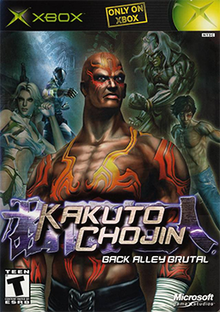2002 video game
Kakuto Chojin: Back Alley Brutal (Kakuto Chojin for short), known in Japan as Kakutō Chōjin: Fighting Super Heroes (格闘超人 ファイティング スーパーヒーローズ, Kakutō Chōjin Faitingu Sūpāhīrōzu), is a fighting game for the Xbox gaming console published in 2002 by Microsoft Game Studios. The game was the sole product of developer Dream Publishing, a studio created by members of DreamFactory and Microsoft. It was originally created as a tech demo to show off the graphic capabilities of the Xbox, before the decision was made to turn it into a full game. A few months after its release, Kakuto Chojin was pulled from distribution amidst controversy surrounding the religious content featured in the game.
Gameplay
Kakuto Chojin is a fighting game generally set in a three-dimensional arena, similar to 2001 games such as Tecmo’s Dead or Alive 3 and Namco’s Tekken 4. There are thirteen fighters, each with their own arena. Each character has two styles of fighting; the "Kakuto" style is the only one available at first, with the "Chojin" style acquired after beating Story mode with a character. Kakuto Chojin attempts a different fighting system in that it lacks buttons meant specifically to punch and kick, instead assigning controls to high, middle and low attacks, along with the ability to unleash a special attack. The left trigger allows for free movement around an arena, while the right trigger is used for blocking and an attack modifier. Besides the Story mode, there are the standard Practice and Vs. modes. Kakuto Chojin allows for a Battle Royale with four players at once.
Development
Kakuto Chojin: Back Alley Brutal was developed by Dream Publishing, a subsidiary of the fighting game company DreamFactory and publisher Microsoft Game Studios. The game was first introduced as "Project K-X", a technology demonstration for Microsoft's then-new Xbox console, at the Spring Tokyo Game Show in 2001.[2] Seiichi Ishii, head of the project's development, stated that the prototype only ran at a frame rate of 30 frames per second, but was doubled when the team molded the demo into a finished product.[3]
Reception
Kakuto Chojin, though heavily hyped and praised for its graphics, received "generally unfavorable reviews" according to the review aggregation website Metacritic.[4] Critics and gamers cited its shallow gameplay, weak Story mode, and lack of bonus material. Game Informer described it as a Tekken ripoff; coincidentally, a portion of the Kakuto Chojin development team were indeed ex-Tekken developers.[9] In Japan, Famitsu gave it a score of two sevens, one six, and one seven for a total of 27 out of 40, while Famitsu Xbox gave it a score of one seven, one six, one nine, and one eight for a total of 30 out of 40.[8]
Controversy
Kakuto Chojin was pulled off store shelves in early 2003 due to accusations of containing offensive religious content.[17] The recall allegedly stemmed from Quran verses chanted in the background of the theme song for the Middle Eastern character Asad.[18] Microsoft senior geopolitical strategist Kate Edwards consulted with an Arabic speaker within the company. This latter person vehemently objected to the release of Kakuto Chojin due to its "incredible insult to Islam"; the game still debuted in North America in the publisher's belief that the content would not be noticed.[18] According to a Microsoft spokesperson, the company was pressured into destroying un-shipped units of Kakuto Chojin containing the chant and attempted to reissue the game as an amended product. However, many uncensored copies still inadvertently made it to retailers.[19] This included locales in which such material is particularly sensitive, like Saudi Arabia, where the issue became headlines news.[20] Three months later, the Saudi Arabian government formally protested, forcing Microsoft to withdraw the game worldwide.[18]
